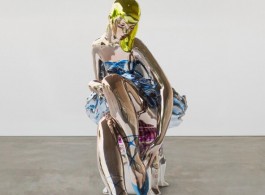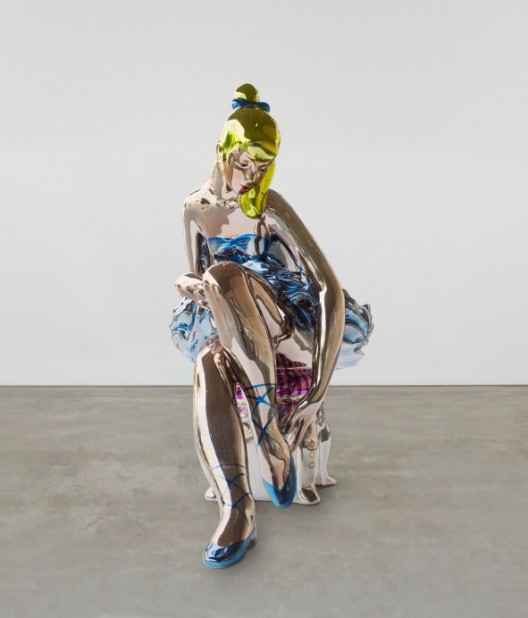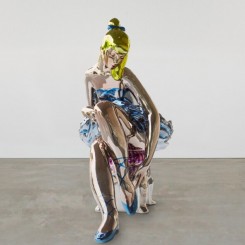Opening on October 4, 2016 / 6 – 8 pm
Almine Rech Gallery is pleased to inaugurate its second London space on Grosvenor Hill with a solo exhibition by Jeff Koons from October 4, 2016 to January 21, 2017. The exhibition is comprised of paintings and sculptures from the ‘Gazing Ball’ series, as well as ‘Ballerinas’ sculptures. A catalogue with essay by Sir Norman Rosenthal will be published for the occasion.
“Great artists are always complex and complicated figures. Unlike philosophers, they are also able to simplify matters, enabling understanding at a single glance by which all is revealed. Ut pictura poesis – ‘as is painting so is poetry’: an insight conjured by the Ancient Greeks and Romans. Mirrors from the very beginning have played an essential role in almost all of Jeff Koons’s work. They appear in the first inflatables of 1979, in which glass flowers and other ‘trite’ objects picked up in cheap stores on New York’s sidewalks were placed on mirrored platforms and backdrops. Since, many of his most ambitious works, such as the balloon swan, monkey and rabbit, shown spectacularly in New York in 2013, are finished with such shine that the viewer cannot but be aware of themselves many, many times as they circle the sculptures.
Koons goes further than Duchamp, who so famously described the viewer as the essential completer of the work of art, by literally embedding the viewer in his works of art, and as a result plays with their memories of childhood and, more recently, educated cultural experiences as they remember classical sculpture or the history of European painting dating from the Renaissance down to Picasso. Now for the first time he gives a nod and a wink to the originator of conceptualism, whose name is synonymous with art that makes pure and abstracted thought visible. At least that might be one way of describing the inventor of The Large Glass (1915-23). This all leads seamlessly into the concept of the blue glass gazing ball that Koons has now given, as though almost a gift, to some of the most decisive, at least as he regards them via museum encounters, masterpieces of Western European painting.
The gazing ball as such is an object often to be found residing in suburban American back and front gardens and yards, perhaps poised atop a birdbath. However, the conceit of the gaze, not to mention the globe that in its planetary way reaches in all directions whilst, mirror-like, receiving images from the space around it, has deep cultural resonance. Both the high and the low are inevitably related in all of Koons’s works. The gaze itself is inevitably part of the natural quest for the image, one that is forever and eternally changing, even as we look. The viewer is constantly changing too, from day to day, minute to minute, even as the image itself, whether in this exhibition or in many of Koons’s other ‘Gazing Ball Paintings’ as he chooses to call this body of work, undergoes its own constantly subtle changes. This applies equally to his version of Giotto’s Judas Kiss (the original of 1304-06 is in the Scrovegni Chapel in Padua), or Tintoretto’s The Origin of the Milky Way (1575, now in the National Gallery, London). Some may be tempted to call these versions copies, but that is to denigrate their individual bewildering and stupefying execution, where every nuance of colour, not to mention craquelure and other signs of ageing, have been hand-wrought by the artist and his assistants – Jeff runs his studio like that of a Renaissance master – even if they are not all reproduced necessarily at a 1:1 scale. Where Walter Benjamin famously argued that the ‘sphere of authenticity is outside the technical’, here, with these evocations of great old master paintings, it is in the amazing insanely hand-wrought technique that the transformation of the greatness of the past into the present takes place akin to a great writer or composer who holds up a metaphorical gazing ball to transform or mirror the poetry of the Ancients, bringing it to new life. Think just of Shakespeare as he reinterprets for his own Elizabethan age the dramas of the Ancient Greeks and Romans. Indeed, it is a matter of contemporary observation to note that Koons is not alone today in finding strategies to transform and make relevant mythic art inventions of past ages for the present.
However, if we follow the trajectory of Koons’s career, from his earliest works plugged into American popular culture, from Bugs Bunny and Mickey Mouse to Hunk Elvis and Betty Page, we can now more than ever see all these figures as transformations of distant European and other cultures. Jupiter and Hercules, Venus and Daphne are retransmitted to us from past times just as great master painters such as Nicolas Poussin, who himself in his own time was a highly contemporary artist, transformed the classical and Biblical past for his cardinal and aristocratic clients, as did his artist peers. Who is François Boucher’s Nude on the Sofa (1752, now residing in the Alte Pinakothek in Munich) other than the Betty Page or Lady Gaga of her time? Both transform themselves through Koons’s art into immortal heroines of beauty, as was in her own time the famous Cicciolina. Aphrodite, after all, was continually reinvented by Greek artists in the third century BC and even before, each permutation drawing on subjective compositional fantasies.
This is an extract from ‘Jeff Koons: The Shining of Time’, 2016, an essay by Norman Rosenthal, part of the illustrated catalogue on Jeff Koons to be published by Almine Rech Gallery.



